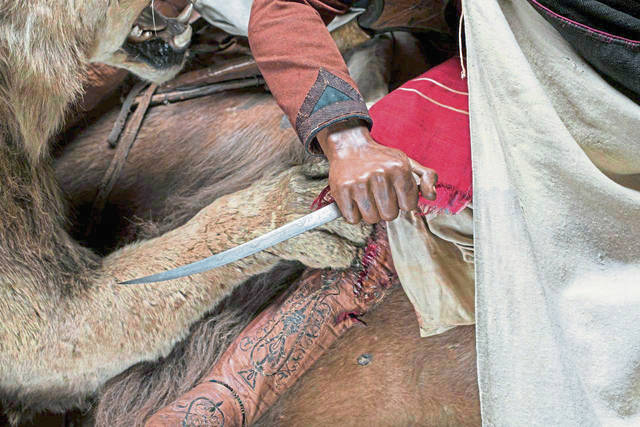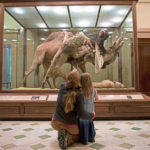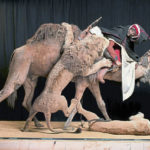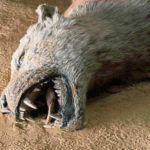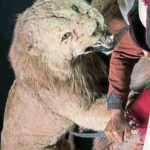It’s a visceral scene that has made an indelible impression on countless schoolchildren and many other visitors to the Carnegie Museum of Natural History for generations.
A fight for survival is at the heart of the famous “Lion Attacking a Dromedary” diorama depicting a violent encounter between two lions and a courier riding a dromedary — a one-humped camel. A ferocious male lion is in full attack mode as a female lion lies dead. Fear is prominently displayed on the courier’s dark brown face, and the camel appears to be in anguish.
Now, for the first time in 120 years, the diorama cannot be seen. The museum has covered it up.
Stephen Tonsor, the Daniel G. and Carole L. Kamin interim director of the Carnegie Museum of Natural History, said the reason for the diorama being removed from view intersects with recent events and demonstrations related to systemic racism and the police killings of Black people.
“For some people of color, their traumatic experience with racialized violence leads them to see this diorama primarily through that lens. And they’ve told us it’s disturbing to them to see a person of color be violently attacked, especially when it’s displayed in such a prominent place in the museum where you cannot avoid it,” Tonsor said. “Nowhere else in our dioramas do we see humans. There are no white European humans in dioramas, and certainly no white European humans being attacked by animals.”
The piece was constructed by French naturalist and taxidermist Edouard Verreaux and his brother, Jules Verreaux, for the Paris Exposition of 1867. It has been on display at the Carnegie since 1899. Over the decades, it has become a popular attraction.
In a 2015 marketing poll, it came in second behind the “Dippy” dinosaur statue outside the museum. Then in 2017, the diorama was refurbished and moved out of the hall of North African mammals to a more prominent spot at the entrance to the museum. The name was changed as well, from “Arab Courier Attacked by Lions” to “Lion Attacking a Dromedary.” The new name “better reflects the exhibit’s storyline. The change also seeks to dispel a long-held stereotype,” said an article in Carnegie Magazine at the time. “The rider misrepresents an Arab from North Africa, which is common in 19th-century art.”
That same year, the more visible display of the diorama helped to stir up controversy related to charges of historical inaccuracies and racism. The museum sponsored a public symposium to discuss the diorama and determined it presented a “stereotyped, colonialist misrepresentation of North Africa and the Middle East.”
Tonsor said the museum’s concerns about the diorama go beyond current events.
“This diorama is a marvelous work of art, but it’s not an accurate portrayal of much of anything. The two lions, for example — one is a male and the other is female, and she is lying on the ground and the male is attacking the man and the dromedary. That’s pretty unusual,” he said. “Among lions, it’s really the females who are the hunters. So, that’s one example in which the biases we have in Western culture about male dominance lead to misrepresentation of what happens in the natural world.”
Tonsor said, in general, Western cultural norms are reinforced by the way in which this diorama was put together.
“The male figure, the so-called ‘Arab’ who is riding on the dromedary, is also somewhat imaginary. We’ve looked at his costume, and it is derived from five different North African cultures. So, it’s not a realistic figure. He’s a construction of what these French brothers imagined an Arab was like.”
Another problematic aspect of the diorama has to do with its display of human remains, which wasn’t addressed three years ago when it was discovered by a University of Pittsburgh student researcher.
“As was often the case in taxidermy (in the 19th century), the taxidermists would use actual bones to help build a realistic form on which they would then build the rest of the figure,” Tonsor said.
After X-rays confirmed the figure of the Arab man in the diorama contained a human skull and jaw, museum officials were faced with an ethical problem concerning the display of human remains.
“While we don’t have a policy that would prohibit it, we do have an ethics policy that says remains should only be displayed in ways that respect the cultural traditions of the people from which those remains come and have the permission of the people whose remains are displayed.”
Tonsor said it’s impossible to know at this point where these remains came from.
Now the museum faces the question of how and when, if ever, “Lion Attacking a Dromedary” can be put on display once again. Tonsor said he knows talking about it but not allowing people to see it is a problem. A number of options are being discussed. One of them is to set up the diorama in a way that people can view it if they want to or easily avoid it.
“We don’t want to be prescriptive and tell people how they ought to see this. We do want whoever encounters this to understand the differences in experiences that people have when they see it. In that way, we hope to bring some light on larger issues in our culture of sometimes being blind to each other’s experiences.”







